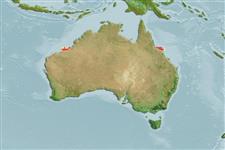>
Blenniiformes (Blennies) >
Blenniidae (Combtooth blennies) > Blenniinae
Etymology: Meiacanthus: Greek, meion = less = lessen + Greek, akantha = thorn (Ref. 45335); luteus: Specific epithet means 'yellow', referring to the brilliant upper body coloration of the species..
Environment: milieu / climate zone / depth range / distribution range
Ökologie
seewasser riff-verbunden; tiefenbereich 0 - 35 m (Ref. 7401). Tropical; 19°S - 20°S
Western Pacific: northern Australia, from Western Australia to Queensland.
Size / Gewicht / Alter
Maturity: Lm ? range ? - ? cm
Max length : 10.3 cm TL Männchen/unbestimmt; (Ref. 2334)
Kurzbeschreibung
Morphologie | Morphometrie
Rückenflossenstacheln (insgesamt): 4; Rückenflossenweichstrahlen (insgesamt): 26-28; Afterflossenstacheln 2; Afterflossenweichstrahlen: 16 - 18. Males with prolonged pelvic fins and caudal-fin lobes; extending from front of snout through eye and caudal-fin base is a midlateral dark brown to black stripe; another dark brown stripe commencing above eye and passing dorsally on body at base of dorsal fin; head and body between 2 stripes bright yellow, below white (Ref. 27362).
Oviparous. Eggs are demersal and adhesive (Ref. 205), and are attached to the substrate via a filamentous, adhesive pad or pedestal (Ref. 94114). Larvae are planktonic, often found in shallow, coastal waters (Ref. 94114). Poisonous canines provide considerable protection from predators.
Life cycle and mating behavior
Geschlechtsreife | Fortpflanzung | Ablaichen | Eier | Fecundity | Larven
Oviparous, distinct pairing (Ref. 205).
Randall, J.E., G.R. Allen and R.C. Steene, 1990. Fishes of the Great Barrier Reef and Coral Sea. University of Hawaii Press, Honolulu, Hawaii. 506 p. (Ref. 2334)
IUCN Rote Liste Status (Ref. 130435)
Bedrohung für Menschen
Venomous
Nutzung durch Menschen
Mehr Information
Alter/GrößeWachstumLänge-GewichtLänge-LängeLängenhäufigkeitenMorphometrieMorphologieLarvenLarven Pop.Dyn.RekrutierungDichteBRUVS
ReferenzenAquakulturAquakultur ProfilZuchtlinienGenetikElectrophoresesVererbbarkeitKrankheitenVerarbeitungNutrientsMass conversion
PartnerBilderStamps, Coins Misc.LauteCiguateraGeschwindigkeitSchwimmstilKiemenoberflächeOtolithsGehirngrößeSehfähigkeit
Tools
Zusatzinformationen
Download XML
Internet Quellen
Estimates based on models
Preferred temperature (Ref.
123201): 25.8 - 27.3, mean 26.1 °C (based on 52 cells).
Phylogenetic diversity index (Ref.
82804): PD
50 = 0.5000 [Uniqueness, from 0.5 = low to 2.0 = high].
Bayesian length-weight: a=0.00562 (0.00258 - 0.01228), b=3.06 (2.87 - 3.25), in cm total length, based on LWR estimates for this (Sub)family-body shape (Ref.
93245).
Trophic level (Ref.
69278): 3.4 ±0.4 se; based on size and trophs of closest relatives
Widerstandsfähigkeit (Ref.
120179): hoch, Verdopplung der Population dauert weniger als 15 Monate. (Preliminary K or Fecundity.).
Fishing Vulnerability (Ref.
59153): Low vulnerability (10 of 100).
Nutrients (Ref.
124155): Calcium = 138 [71, 244] mg/100g; Iron = 0.902 [0.532, 1.576] mg/100g; Protein = 17.9 [16.7, 19.0] %; Omega3 = 0.0948 [, ] g/100g; Selenium = 26.2 [12.5, 59.7] μg/100g; VitaminA = 186 [55, 673] μg/100g; Zinc = 2.04 [1.35, 2.94] mg/100g (wet weight);
